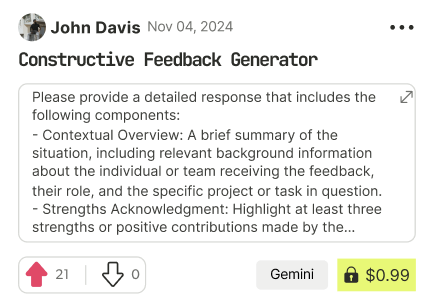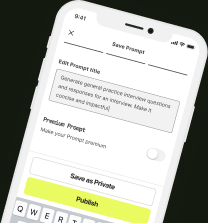prompt mine App
Find, Create & Share AI Magic
Systematic Coding: Puzzle Box Method
Of course. Let's approach this Python coding challenge like a true artisan, using the Puzzle Box Method to craft a solution with precision and care.
Phase 1: Sketch the Mechanism
First, let's understand the puzzle completely.
Problem Statement: We need to create a Python function that takes a list of candidate numbers and a target integer. It must return a list of all UNIQUE combinations of those numbers that sum up to the target. A key detail is that each number in the candidates list can be used only once in each combination.
Inputs:
A list of integers, let's call it candidates.
An integer, let's call it target.
Outputs:
A list of lists, where each inner list is a unique combination of numbers from candidates that sums to target.
Initial Logic Flow: This problem smells like we need to explore many different possibilities. A backtracking or recursive approach is perfect for this. We can think of it as building a decision tree. At each step, we decide whether to include a number in our current combination or skip it. To avoid duplicate combinations (like [1, 2, 5] and [2, 1, 5]), we should sort the input numbers first. This helps us ensure we only build combinations in a consistent, non-decreasing order.
Phase 2: Build the Pieces
Now, let's outline the core components of our function using pseudocode. This is like carving each individual piece of the box before assembly.
We'll design a primary function, combinationSum, and a helper function, findCombinations, to handle the recursion.
Function: combinationSum(candidates, target)
Initialize an empty list called results to store our final combinations.
Sort the candidates list. This is CRUCIAL for handling duplicates efficiently.
Call our recursive helper function: findCombinations(results, [], candidates, target, 0).
Return the results list.
Recursive Helper Function: findCombinations(results, current_combination, remaining_candidates, remaining_target, start_index)
Base Case 1: If remaining_target is 0, we found a valid combination. Add a copy of current_combination to results and stop this path.
Base Case 2: If remaining_target is less than 0, this path is invalid. Stop and backtrack.
Recursive Step:
Loop through remaining_candidates from the start_index to the end.
To handle duplicates: if the current number is the same as the previous one and we are not at the very beginning of the loop, skip it. This prevents using the same number to start a new combination path.
Add the current candidate number to current_combination.
Make the recursive call: findCombinations(results, current_combination, remaining_candidates, remaining_target - current_candidate, current_index + 1).
Backtrack: Remove the number we just added from current_combination so we can explore other paths.
Phase 3: Test the Lock
Finally, we test our mechanism to ensure it works perfectly and smoothly.
Debugging and Refinement:
The most common bug here is generating duplicate combinations. Sorting the input array and adding the logic to skip identical adjacent numbers (if i > start_index and candidates[i] == candidates[i-1]: continue) directly solves this.
Another potential issue is modifying the current_combination list across different recursive calls. That's why we add a COPY of it to our results (results.append(list(current_combination))).
Example Test Cases:
Edge Case: candidates = [10, 1, 2, 7, 6, 1, 5], target = 8. Expected output should include [1, 7] and [2, 6] and [1, 2, 5] and [1, 1, 6].
No Solution: candidates = [1, 2], target = 5. Expected output: [].
Empty Input: candidates = [], target = 1. Expected output: [].
Optimization: The backtracking approach with sorting is quite efficient for this problem. By pruning branches where the sum exceeds the target and by skipping duplicates, we avoid a lot of unnecessary computation. The solution is clear, correct, and performs well for typical constraints.

Find Powerful AI Prompts
Discover, create, and customize prompts with different models, from ChatGPT to Gemini in seconds

Simple Yet Powerful
Start with an idea and use expert prompts to bring your vision to life!

